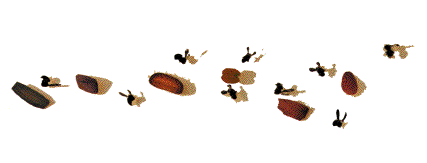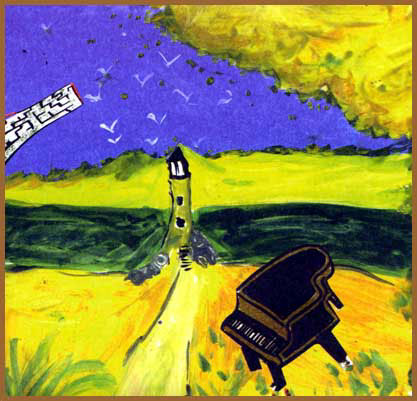|
Sale Timbale

Philippe Blanchard — “Sale Timbale”
Four electroacoustic / concrete fairytales in Greek, Spanish, German and English:
“Katastrophe” / “Casimir” / “A
la bataille” / “Hopscotch”.
Editions Suicide
Commercial
Ok, remain calm! That is what I told
myself when I received this CD from Philippe Blanchard. If ever there was
a CD that could make you insane before you even heard it; this is it! That is because
it comes inserted in a maze of CD-cover-size hard paper pieces, which are all attached
to each other, but folding up in different directions… In fact, it’s one piece of
hard paper, 12 times larger than a CD cover, with certain cuts made that makes it
possible to unfold it all and put it flat down on the floor, to get an overview of
the children’s’ paintings and other stuff that is pictured on the paper … Maybe you
can construct a house or something by folding the paper in certain manners, but I
haven’t had the patience to do that… Maybe it is supposed to work like a hopscotch
for your fingers and your mind…
I’m not sure who’s done what (except that Philippe Blanchard has done the
music, the electroacoustics on the CD!), but there are credits to all these entities
printed in different places of the maze, so they all must have something to do with
this project:
Studio Acteon
http://ourworld.compuserve.com/homepages/acteon
acteon@compuserve.com
Editions Suicide
Commercial
http://perso.wanadoo.fr/suicide.commercial/
suicide.commercial@wanadoo.fr
ISBN 2-9509100-3-3
Pierre Bouchet
Agent d’art
12, rue docteur Mazet
F-38000 Grenoble
Tel/Fax: —33 (0) 476 503 425
I found an “explanatory” text somewhere on the folding and unfolding maze of hard
papers, saying:
“It’s a book
for every sense of the body, and any sense of direction. Here are a few selected
extracts produced during Pierre
Bouchet’s
interventions. In this intervention, the volume of the display space is cut into
colored flags, “la
Marelle”
and the listening of the tale “A
la bataille”.
Presented in four versions, “A
la bataille”
becomes “Casimir” in German, “Katastrophe” in Greek, “Hopscotch” in English. “La Marelle” is divided in six modules.
Each one can be unfolded, opened out, laid flat or closed again. The persons taking
part in the experimenting of these elements give an interpretation on the “stereotype”,
which is identical to this aid, but blank. This book isn’t finished! Your turn to
play!”
Even after I’ve corrected some of the mistakes of the English lingo that these Frenchmen
made, I’m not sure I understand the complete content of the text above… I decided
to fold the hopscotch hard paper never to open it again, never to get lost in useless
investigations into the credits, the purpose and so on, and instead just listen to
the music, which is why I’m here anyway… and the music of Philippe Blanchard
is magnificent, in that typical, refined, poetic French style of electroacoustics!
The first version of the fairytale is in Greek, and I have an uncanny faiblesse for
the Greek language inside electroacoustic environments ever since Pierre Henry’s
“Voile d’Orphée” (1953), much later followed by the touching
and dreamy, austere “Tramontata
è la luna” by Swedish
cellist and composer Peter Schuback, in which he uses fragments of the poems
of Sapfo — spoken by Marcia Cavalcante - along with his cello and diligent
electroacoustic manipulations.
“Katastrophe” begins with sounds of water, splashing,
someone falling in, gulping for air, directly followed by fluttering of bird wings,
a giggle and the typical sounds of a rural landscape, with dogs barking in barn yards,
wind blowing through leafy crowns, and so on.
The drowning sounds recur, amplified, and someone is desperately trying to survive.
Soon a duet or duel between deeply murmuring double basses and barnyard dogs follow,
with insertions of sea birds and rushing seawater…
It is bewildering, but very intelligibly done, i.e., it works!
At one instance you hear the wildly chattering gulls at a distance, with the wind
through leafy tree crowns comparably much louder, as if you were sitting under an
oak in a pastoral, cow-scattered meadow near the sea. A propeller airplane passes
by on high, and you feel like you’re in some kind of childish hiding under the oak,
protected by the sound of the wind through the leaves, with your parents or maybe
your playmates looking for you — or maybe you’re just in a subconscious retreat into
childhood from your painful present life of down-weighing duties…
A child’s voice emerges, humming the way kids do to themselves when hypnotized by
their solitary games. You even get a notion of Karlheinz Stockhausen’s “Gesang der Jünglinge” at this point, but purely by association,
since that Stockhausen piece has become archetypical in our minds of musical
reference. This short formula of the child is layered and repeated like a mantra,
taking on a deeper meaning along the way, until it fades out in a silence, in which
a female voice tells the story in Greek. This storytelling is interspersed and saturated
with musique concrète illustrations throughout. When the storyteller gets
silent for a while, the humming of the child, now more clearly melodious, is appearing
in different electroacoustic guises, taking on the character of a psalm or an Middle
East prayer, as a farmer spreads straw in a pigsty.
Many other sonic events blend into this highly colorful tapestry of sounds, like
short spurs of electric guitar solos and samplings from some kind of classical ensemble,
like a string trio or something like that, attached to the amplified sounds of bees
or bumble-bees.
Philippe Blanchard must have laid down quite a bit of time in the studio and
on the field to get this lot together, and not anyone would be able to make any compositional,
aesthetical sense of the maze of sounds, but Blanchard does it with flying
colors. All these sounds, so many of them, breeze by, and the associations are so
many and so fast that your thoughts stumble over themselves in the process of listening.
Maybe Blanchard is trying to use the sounds as pure sounds, without the associations
they might give a listener, but that is not working, because when a sound is readily
recognizable - the way it usually is in musique concrète - an association
is glued to it!
Anyway, this Blanchard music is like an experimental movie, where pictures
are shown by different projectors all around the walls of a dark room, at enormous
speed, and randomly, showing you bits and pieces of your life or of human life in
general.

Somewhat later in the piece Blanchard
picks up the bees again and uses them just like he would a regular string instrument,
in a motet-like progression of metallic synthesizer sounds in a droning repetitious
game — quite beautiful; a submarine cathedral in the dream of a sleeping child!
The Greek woman returns singing the fairytale as the bees circle and spiral her.
Short gasps of instrumental sounds pair up with nature sounds and synthetic sounds
in a flabbergasting show off by Philippe Blanchard.
The woman resorts to speaking the text, in a nagging kind of way for a short instance,
before breaking into a way of talk-singing that sounds just like the chanting of
a Catholic priest!
As a silence falls a man is clearing his throat while something unidentifiable is
going on; maybe some kind of ball game.
The woman returns with the continuation of the fairytale, in a matter-of-factly manner,
like a teacher reading to her class. She doesn’t talk for long before a jumble of
approaching sounds, now almost free of their objects, free of their associations,
approach outside, slowly invading the rooms with their mystique.
Dark ambisonics from the double basses mix with pigsty sounds of grunting sows in
a Marcia Funebre, moving into a duet of shrill, fluttering violin strokes and deep
pig grunting. Short events of a Giacinto Scelsi-like string world swagger
through the listening space, until a submerged state of sonics reminiscent of the
atmosphere of Gavin Bryar’s “The
Sinking of the Titanic” slowly
invades the whole area.
The neighing of a horse appears for the first time, as you look out of the pigsty.
At about 18 minutes into the piece a sound poetic female event takes place. The woman
in these vocalisms sounds so much like the sound poet Hebriana Alainentalo
of Sweden that I start to wonder if some of her many private cassette recordings
have made it to Blanchard’s studio by mysterious doings of unknown diffusers
of sonic adventures!
The next version of the fairytale is in German, called “Casimir”.
It begins in a rhythmic, marching manner of a synthetic bass, soon mingling with
fast, rusty sounds of synthetically screeching chain events, in a Jean Schwarz
atmosphere.
The German storyteller is also a woman, but a different one from the Greek one. She
has a deeper voice, and is probably younger too.
It is fun to realize how much he language itself colors the general impression of
the fairytale and the music!
I also realize that when I understand the words (I do understand German and English
and some French, but not Greek), the sounds take on a more illustrative guise, making
them somewhat more attached, less free, than in the Greek version — in my linguistic
ears…
The ingenuity of sound application is as remarkable in the German version, though,
but completely different in shadings, colors, nuances. Philippe Blanchard
is a master of his tools, and he has a vivid imagination!
A pigsty choirs, beautifully synchronized, soars in the background, while hopping,
bouncing imaginary bubbles fill up the screen, or the room. Someone empties a whole
sack of potatoes at your feet, and you’re rural, definitely very rural! The sounds
of the potatoes tumbling out of the sack transforms into something that sounds more
like a sack of charcoal emptied into a bin at the heater in the basement. Until it
is stretched out to form a continuous imaginary sound of the Van Allen Belt — or
the secret thoughts of the Rabot Glacier at Kebnekaise, shaking off
some rocks at its edge…
Third version is French. Children’s’ voices in the left channel are joined by Jean-Claude
Risset sounds in the right. The tale is now called “A la bataille”.
A rhythmic sequence of indecent sounds of the oral cavities plus human grunts and
saliva-spraying carelessnesses build up the scene for the story. The child’s voice
that then appears in a solo of spoken words is immediately transformed in a sound
poetic manner, sped up and slowed down and circled and spiraled, cut-up and elastically
stretched, ballooning, swirling and hitting down like a hammer on nails into wood!
A humorous melody is fashioned from this ill-treated voice. It continues for a while,
on a backdrop of a steadily building layer of deep, brownish, mud-sounds.
A male voice carries the story through the French version. The sound of a railway
crossing breezes by a few times (as heard from inside the train) in an old Pierre
Schaeffer style, slowing down, making the signal at the crossing sound like brittle
wine glasses hit by pencils.
The ingenuity of sound is almost devastating, as scrapings of unknown surfaces —
maybe the sharpening of scythes or knives on a grindstone — mingle with austere violin
sounds, not unlike the reverberant violin solos of Mary Lou Newmark of California.
There is a strange sense here of ancient days and the present, layered on top of
each other, behind each other, with the ancient layer sometimes appearing as more
present than the present and vice versa, turning the history of human culture inside
out, revealing a few truths in the process. Fascinating!
The last version of the story is called “Hopscotch”, so it’s the English version. It opens in
a space sound manner, in a roaring, trembling sense of shuddering through the upper
layers of a planet’s atmosphere, shaking your body violently, relentlessly — but
inside it all is the sound of ping-pong balls bouncing; is that inside a frantic
memory of a space traveler, alienated from all human contact, worlds away; a sole
survivor of an extinct humanity traveling towards his distant death among the stars?
As the male English storyteller begins to speak it gets all the more obvious how
many of the sounds are illustrative, but I prefer, in this review, to consider them
by themselves, as someone without knowledge of the language would hear them.
A rubbed balloon sounds just like an albatross taking of from the Falklands.
The winding up of an old alarm clock — or a big grandfather’s clock — while the storyteller
speaks, teams up with sharp, high-pitched elastic sounds. Little popsicle synth-sounds
are inserted, as well as quirky sounds of a digitally reproduced analog synth, perhaps
— it sounds just like it — loops of ReBirth RB 338 from Propellerheads.
These quirky synth loops are joined by female inhalations, as some lady is gasping
for air. Apparently an intercourse is in full swing inside the sound web!
This hastily transforms into a subway ride or a walk through the sewers; I can’t
make up my mind as to which it is, but it probably is both… and sex too!
It has been an adventure to soar through these sonic landscapes, breeze through these
bewildering cuts and bruises of a world gone wrong with a smile, a world disappearing
with a quirky jolt, a culture going down the universal drain with a fatalistic grimace.
Fantastic, Philippe!

|

